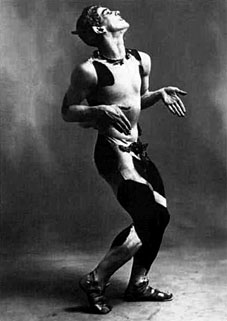 I have an abiding fascination with the Ballets Russes, Sergei Diaghilev‘s company which electrified the art world from 1909 up to the impressario’s death in 1929. One of the reasons for this—aside from the obvious gay dimension and the extraordinary roster of talent involved—is probably Diaghilev’s success in carrying the Symbolist impulses of the fin de siècle into the age of Modernism without losing any richness or exoticism along the way. Diaghilev’s arts magazine, Mir Iskusstva (1899–1900), was as much a product of fashionable Decadence as The Savoy, and its principles were easily transported into the world of ballet.
I have an abiding fascination with the Ballets Russes, Sergei Diaghilev‘s company which electrified the art world from 1909 up to the impressario’s death in 1929. One of the reasons for this—aside from the obvious gay dimension and the extraordinary roster of talent involved—is probably Diaghilev’s success in carrying the Symbolist impulses of the fin de siècle into the age of Modernism without losing any richness or exoticism along the way. Diaghilev’s arts magazine, Mir Iskusstva (1899–1900), was as much a product of fashionable Decadence as The Savoy, and its principles were easily transported into the world of ballet.
A big subject, then, that’ll no doubt be returned to in later postings. Looking around for images of dancer and choreographer Vaslav Nijinsky in his celebrated (and notorious) role in L’Après-midi d’un Faune turned up not only Leon Bakst’s luscious drawing but some marvelous Beardsley-esque pictures by George Barbier (1882–1932). I’d seen some of Barbier’s work before but didn’t realise he’d created a whole book devoted to the dancer. Artists like Bakst, Erté and Barbier show how Aubrey Beardsley’s art might have developed had he not died prematurely in 1898. You can see the full set of book plates here.
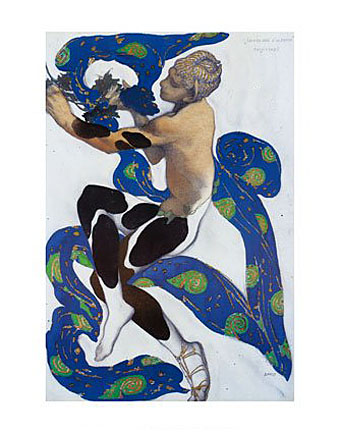
Nijinsky as faun by Leon Bakst (1912).
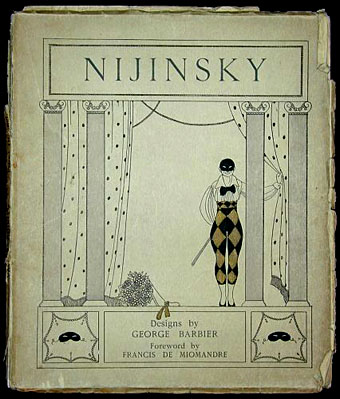
Designs on the Dances of Vaslav Nijinsky (and below) by George Barbier (1913).
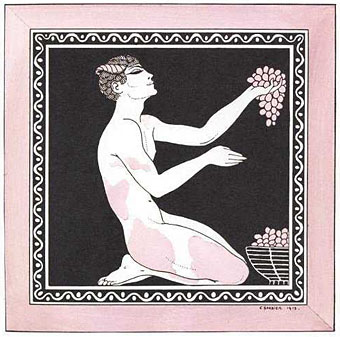
L’ Apres-midi d’un Faune.
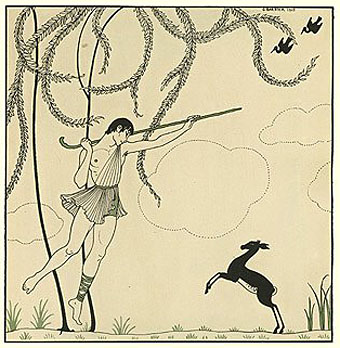
Narcisse.
Elsewhere on { feuilleton }
• The gay artists archive
• The illustrators archive
Previously on { feuilleton }
• The art of Nicholas Kalmakoff, 1873–1955

Because I was – still am -a fan of Jean Cocteau as a kid, I was – still am – a fan of the Ballets Russes and of the iconography they generated.
I was not aware that also Barbier, whose mode drawings I kept a folder of then (only reproductions, alas) has drawn on the subject but he is not a very distributed artist, when compared to Beardsley and Erte (two other favourites – we had extended mongraphies of these two at home), whose style I always thought he was bridging somehow.
It’s a shame Barbier isn’t better known, he seems to have less of a reputation than Alastair, a Beardsley imitator of the period who couldn’t draw very well but who hung around with rich people and got his work about.
Barbier’s work I know mainly from books about Art Deco design which is where you often see some of the pictures on the Artophile site linked above.
Some of the prints are also available on ebay… (not the “Après-midi d’un faune” though)
For some strange reason, it seems that Barbier was never treated to a monography of his own but is banned to making appearance in collective works. For instance, I have found him in a book I have about “Folies Bergères” illustrations. His “Roses dans la nuit” is very often used in books on fashion (as many others – at a quick glance in the costume making section of my bookshelves I found “la Joueuse de Théorbe” in one of the books of fashion history) but even a search in Chapitre.com for rare or out of print books does not give any results.
The numbered edition of the Nijinsky book can be had for a mere $7500.
http://www.manhattanrarebooks-art.com/barbier_nijinsky.htm
He seems well-regarded for his costume renderings yet as you say it’s odd that there’s no books around. Erté was as much of a costumier yet his work never seems to be out of print.
!!!
A real bargain …
:)
Yes, Erté has always been more publicized – and shown too: I remember seing exhibitions of his paintings in a gallery Rue de Seine, in Paris (beautiful things they were, vibrant with colours).
Maybe he was better connected ?
I am an avid collector fo Barbier pochoirs and I am astonished at how productive he was over his short career. Despite considerable research, I have not been able to find our how he died at age 50. Can you solve this mystery? Quite a challenge; no one else has been able to answer this question. Best regards, Dr. Rick Trussell, Calgary, Canada
Hi Rick. Wish I could be of some assistance but information in my books is scant. Same goes for most of the web pages I’ve seen. Sorry about that.
I hadn’t heard of Diaghilev’s arts magazine, Mir Iskusstva. Even though it only lasted from 1899 to 1900, it suggests an interest in costume, sets and every other thing, long before the Ballets Russes got going. Many thanks for the link to your super article.